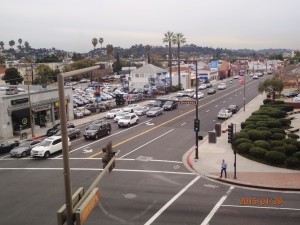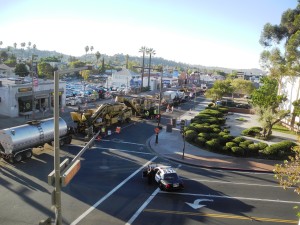Glendale Avenue Wastewater Capacity and Street Improvement Project
The City of Glendale is nominating the Glendale Avenue Wastewater Capacity and Street Improvement Project in the Efficient and Sustainable Road and Bridge Preservation, Maintenance and Construction and Reconstruction Projects category for the 2015 Local Street and Roads Award Program. Glendale Avenue, since when the City of Glendale was incorporated in 1906, remains one of the most important arterials in the City. The Glendale Avenue Wastewater Capacity and Street Improvement Project was a significant infrastructure improvement for the City. It was primarily a large scale project, about two miles long, and included the concrete improvement, sanitary sewer upgrade, pavement rehabilitation, traffic signal modification and striping installation from Broadway to San Fernando Road. The scope of work included many elements. The highlights of which included the installation and reconstruction of curb ramps meeting current Americans with Disabilities Act guidelines; upsizing approximately 1,950 linear feet of sanitary sewer main; rejuvenation of the existing asphalt concrete base using the environmentally friendly Cold-in-Place Recycling method; modifications of seven traffic signals systems; and the installation of flashing beacons at eight pedestrian crossings. The pavement portion involved street resurfacing—rehabilitating Glendale Avenue and nearby streets that had deteriorated beyond normal maintenance work. The street had outlived previous resurfacing, crack seal, and pothole repair work. Street resurfacing consisted of the removal or grinding of the existing deteriorated asphalt concrete pavement, known as a surface planing or cold milling. Subsequently, a new surface layer of rubberized asphalt concrete pavement was installed. The street resurfacing improved the ride of Glendale’s namesake street and the structural integrity of the pavement, and started a new service life for the street. The pavement rehabilitation involved the use of Cold in-Place Recycling (CIR) method to rejuvenate the asphalt concrete pavement. This method used the existing asphalt pavement to produce the reclaimed asphalt pavement (RAP) in-situ. RAP was obtained by cold-milling and crushing the existing pavement to a specific aggregate size. A rejuvenating agent was added. The process was performed in a single-pass “train” of equipment, and then laid directly down onto the road surface as a base pavement course. CIR is an environmentally-friendly rehabilitation method minimizing air pollution since there is no heat or fumes involved in the process. It’s cost effective by reusing the existing pavement thus eliminating transportation costs while reducing traffic disruption. Additionally, Glendale Avenue was open to traffic almost immediately after the CIR RAP was compacted. A typical CIR project is approximately one-half to one-third the cost of traditional total reconstruction methods. Approximately, 8,854 tons of AC were recycled using CIR method, and over 880 truck trips were eliminated. This method has been successfully used last year on Glendale’s Central Avenue Improvements Project. Everyone benefits—less truck travel on the road, less air pollution and less fuel consumed. Glendale Avenue was capped with Asphalt Rubber Hot Mix (ARHM) pavement. ARHM is composed of conventional asphalt concrete mixed with recycled tire rubber material. ARHM provides a longer service life than conventional asphalt concrete. It also provides a smoother and quieter ride while reducing the amount of scrap rubber tires buried in the landfills. As part of this project 13,150 recycled tires were used in the Asphalt Concrete. The Wastewater Capacity Improvement Program is part of the City’s infrastructure maintenance effort, aimed at maintaining the City’s sewer system in the best possible condition. The existing sanitary sewer pipe in Glendale Avenue from Chevy Chase Drive to Maple Street was identified in the City’s 2007 Wastewater Master Plan Update as being deficient. With this project, approximately 1,950, 160 and 1,800 linear feet of the sanitary sewer mains was upsized, repaired and lined, respectively. Since the sewer mains were originally installed, the land use and population have increased in the City causing deficient sewer mains in certain areas. In this particular project, to account for increased wastewater flows and to mitigate potential sewer overflows, deficient sewer mains were replaced with larger diameter pipes. The existing sanitary sewer pipe in Glendale Avenue from Chevy Chase Drive to Maple Street was identified in the City’s 2007 Wastewater Master Plan Update as being deficient. Approximately 1,800 linear feet of 18-inch diameter and 150 linear feet of 21-inch diameter sewer mains were installed as part of improvements. This completed the necessary sewer upgrade in this part of the CIty, which was started with the Palmer Avenue Sewer Upgrade project (completed in 2008). Also, the traffic signals were upgraded at eight intersections, including at extremely busy Chevy Chase Drive and Colorado Boulevard intersection. Also, the new style rectangular rapid flashing beacons were upgraded at eight pedestrian crossings replacing “hard to see and maintain” in-roadway pedestrian warning lights. The final phase was installation of the thermal striping. The zebra striping were installed at 17 pedestrian crossings, including the yellow zebra crossing at the intersections near the schools to improve the pavement marking visibility. The new sharrows, the pavement markings for bike and cars road sharing lane, were installed from Loz Feliz to Cerritos Ave. In terms of funding, the street improvement portion of the project was funded by the City’s annual allocation of Surface Transportation Program – Local (STPL) funds through the State’s Department of Transportation. Caltrans obligated STPL funds for the construction, construction contingency and construction engineering. Glendale received approval to use the Federal Toll Credit in lieu of the local match. As part of the critical community outreach element for the Project, in November 2013, Engineering staff held an informational community meeting to inform the area residents and business owners of the upcoming project. The meeting included a PowerPoint presentation. Public Works Engineering staff consistently and timely responded to inquiries and concerns during all phases of the project and met with affected entities to devise the construction schedule and work execution plan that would have the least impact on everybody affected. For example, the sewer upgrade was completed during school summer break. Most of all, we thanked the public for their patience and cooperation as we invested their trust in promoting preservation, safety and sustainability in the City of Glendale.


